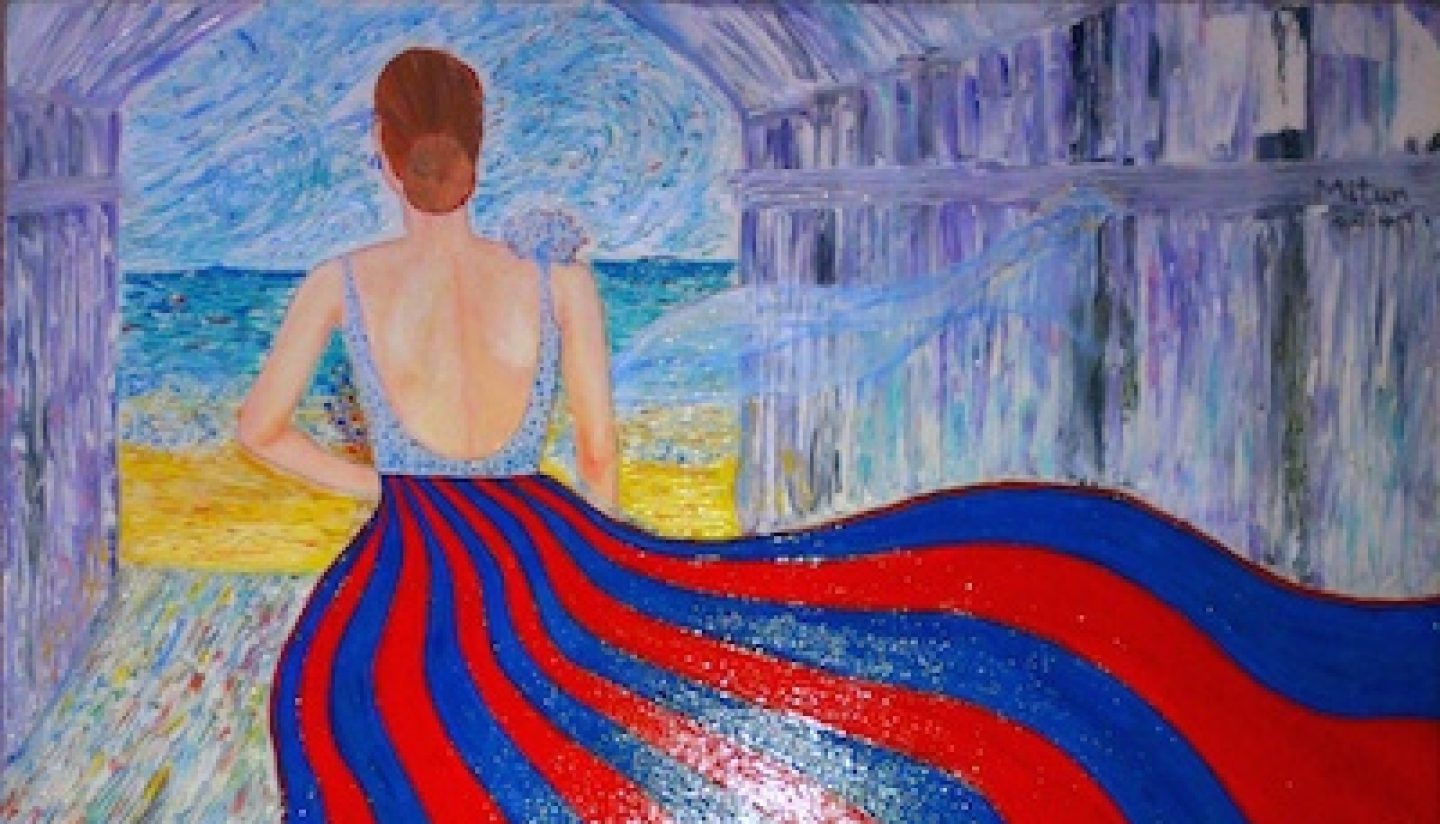Starting a blog to write about my work and this is my first post. One month left before a new year arrives. Wishing in advance a happy new year and may you have a great 2016.
Summary
A new road in painting. A combinative representation, and development of a combinative visual lexicon – to explore depiction of how I see and experience the objects and the world around me. Here I demonstrate the richness of, and the need for, a fusion language: a combination and permutation of all past art styles and movements (-isms) in juxtaposition, which I think is a necessary tool to represent today’s world and split-attentions. And especially to study and realize simultaneous perspectives of multiple viewers.
In composition and in painterly efforts, of special importance to me is the study of perspectives through every eye — of humans, animals, machines … of dissimilarity, divergence as well as interconnections amongst different cultures … of the origin of diversity of views. A lot of thought goes into trying to recreate for the viewers something that would hopefully evoke at least partially, that feeling of inevitable parallelity of our world, projected humbly onto one little canvas. The impossibility of it, despite my long efforts. Maybe I have failed.
As an illustration of the above contemplations, I provide here in this post, a few example paintings that I have worked on, a result of my thoughts for the past ten years. Some of these works have taken years. 2005 was the magic year in which many of these philosophical daydreamings culminated — when I immigrated to America and had pockets of time for brooding in my basket — which then took a few more years of doodling to finally put onto canvas, jumpstarted by my move to another state in 2008, and finally to California’s Bay Area in 2011.
In these painting examples below, I explore: (1) representation of parallel and comparative worlds of perspectives (e.g. of humans vs. machines vs other animals) and their ‘lived’ experiences; (2) motion, dynamics, flow; (3) peripheral vision movements; (4) deliberate pulling of the focus of the viewer’s eye in multi-directions through repeated motifs, patterns, optical illusions, and color fields.
Detailed Statement
Every age has it’s own idiosyncrasies, and the corresponding art needs to be able to accommodate those. The wise words of Jackson Pollock come to mind, which tie together the age and the art.
To repeat Pollock’s widely-quoted views from 1951: “It seems to me that the modern painter cannot express his age, the airplane, the atom bomb, the radio, in the old forms of the Renaissance or any other past culture. Each age finds its own technique.”
This was in 1951. We have since added internet, laptops, technology, smart phones, giant televisions, iRobot, 3D printers, LHC atom collider, nanobiology, 3D vision, better camera-lenses, bigger telescopes, and then Twitter, Google, Facebook and so on. How to represent the resultant increasing dimensions of our presence and point-of-views in paintings?
Artists have found numerous ways and styles to depict modern objects around us, the helicopters, the cars etc in best possible ways. Over time, revolutionary styles and techniques have come out of these studies, including visual languages of deconstructions and erasures of paintings.
At this cusp, the mixture of numerous styles juxtaposed together, would be fun to experimented with. It could eventually lead to the resultant encoding of the visual language of this amalgamated form. Each of the past art movements has its own visual expressiveness, and hence its own language and vibration. In Linguistics, when multiple languages collide, usually a new language is born — a new dialect (for closely linked languages with lexical similarity) and new materials for a new dictionary takes birth upon their mixed usage over time. I believe that this admixture is a necessity in art, in today’s diverse world-representation; especially to bring together all our diverse strengths, visual studies and viewpoints.
Moreover, with ever-expansive scientific awareness of our timespace, from sub-atomic range to galactic light-years, as well as being increasingly made aware of different truths and renditions of creatures and artifacts that we are surrounded with, it is imperative that we study parallel representations of the world around us, to be able to try to represent, in more dimensions, the manifolds of our constant collective lived experiences.
While taking a leisurely afternoon walk in the nearby park, we see yellow flowers in the grass in visible light. The bees apparently see the same flowers at the same time in UV light, and can hopefully see the most honey-filled flowers to land upon — we don’t. So if we paint the yellow opaque-to-us flowers in a landscape painting of the park, it will be a somewhat honest representation for our human eyes, but maybe not for the bee population. Thus this landscape painting would be one form of representation, out of many. Only one truth, one projection, one perspective of what that landscape really is in nature. To evoke the sense of the other truths — however unimaginable by us mere humans, to transfer that sensation to the viewer — we need to gear towards using all the tools in our bag. Hence the absolute necessity for the mixed narratives. Even for us humans, there are split sensory stimulations happening every second, some things we focus on or care about today and some we don’t, and tomorrow that may just invert and we see the landscape in a completely different way in terms of points of interest, feelings and other sensory particulars.
Same with still lifes and indoors. Let’s think about composing an interiors painting. In an average home we have the latest furniture, latest electronic pieces, an antique piece probably, a 20th century painting or sculpture thrown in together in harmony in a room, and still the total décor works out in unison. Combination is not only essential, it’s universal. It’s not a choice, it’s a way of life.
Likewise in paintings, combination is a way of life. It’s a component of painting — along with paint, medium, texture, color, composition, size, subject — that would show its own voice and vibrancy when explored in detail. There is a void that exists here in development of a new visual language that could be invented and explored. Hopefully it would provide opportunities for portraying unexplored or difficult-to-render subjects.
Through my paintings, I study this unexplored space. Each painting is a combination of styles and techniques, achieved through well-thought compositions and by deeply understanding and exploring the languages of the past styles.
I have found the works in all past styles and movements to be fascinating, and learned something unique from each. Each evokes something sensorially different from the viewer, and hence can be used effectively to achieve controlled storytelling, which is one of art’s purposes. Hence, a combination could prove to be a powerful artistic tool of communication.
The old, the new, and the parallel
Living contemporarily, it is not that we have to depict all those newly innovated items in our paintings. But their presence is constantly informing our beliefs, experiences and knowledge, thus influencing our thought-processes and decision-making –a point to be kept in mind for painting compositions.
Most importantly, our thoughts, views and perspectives have changed because of these latest additions and findings that include all the innovations, inventions and scientific discoveries till date. Because of this constant shift in our sensitivities, painting compositions age. Hence, soon we need to represent the same arrangements of artifacts in a different manner to encapsulate our newest learnings. In this backdrop, a recent painting using past techniques would give the feel of the old or incomplete even before the paint had dried on canvas.
Moreover, the collective whole of our knowledge base is not a centralized, uniform, streamlined cloud. It is an unruly, diverse, juxtaposed beast formed out of bits and pieces that are often at odds with each other.
We need to reflect on the essence of this friction that is so inherent of our age, and the mindset of the viewer too, in order to make an artwork look fresh and relevant. Today is not just the sum-total of the newest artifacts we have manufactured, but also a cumulative of all preceding ages, culminating in a union, a temporal melting-pot. Cumulative.
So, we do not want to throw away the old techniques as been-there-done-that-and-done. Neither can we use them as is. And neither do we want to stop experimenting with newer better or different ways to see the same things. At this cusp, the old and the new approaches need to intersect together: running parallel, converging, intersecting, diverging and remixing.
To the human-eye, some subjects have remained the same through every age – flowers, fruits and vegetables (if we don’t take into account the genetic hybrids of these flowers and fruits!), sunflower and white vases, sky, human face, trees, rivers, oceans, mountains, to name a few. Yet again, there are other items that are slowly changing with time – landscapes, furniture, food or fashion. Yet others are fast-changing. Yet others are new additions.
Our times (and all future ages) is a mix of this changing wisdom, and encompasses all the knowledge, discoveries and inventions in arts, sciences and humanities we have collectively made till date. As knowledge goes through constant loops, re-experiments and changes, our perspectives have gone through corresponding evolution, and will keep evolving. This change and mix is eternal.
With this new wisdom-tooth and tongue, we see old subjects in a new light at every age.
In Van Gogh’s Starry Night Over the Rhône (1888), it is amazing to see the Big Dipper covering major portion of the sky. Van Gogh had painted it 127 years ago!
The progress in astronomy has further given us the faraway galaxies, the neutron stars, the pulsars, the exoplanets, seen though the eyes of our telescopes and thus ultimately through the mind’s eye. Thus the subjects that could be depicted are forever expanding. How to superimpose all these parallel truths?
In addition to the water surface or the great waves, we see more and more of the ocean floor as it is being mapped. Here too, the ways of simultaneous representation is food for thought.
Hokusai’s Great Wave off Kanagawa (1831) series is spellbinding in its fractal approach of the ocean surface. Amazing printmaking from 184 years ago!
At present, collectively our mind’s eye is also on the ocean floor, and beyond that all the way to the Earth’s core. How could we unite all these into meaningful depictions so that the viewer could make the spontaneous connections? The precious and enjoyable Aha moments.
There are numerous worldly examples that encourage and ultimately bring forward this age of the mixed in every sense: the mega and the nano sciences, the contemporary and the antique, the ancient relics and the scientific age, the latest technologies and the iron-age tools, the mars-landing and the prehistoric archaeological pieces.
In a nutshell, we simply know too much as a collective human race. I strive to bring this fusion, this unification, this superimposition into my practice. It is a constant struggle, a new land to explore for me about sensemaking. I am here to embrace the full cornucopia.
I hope some representations could be successfully made with a combination of past styles (and upcoming ones) onto single compositions, calling forth a mixture of the –isms and exploring its positives and potentials, borrowing from the strengths and gains of each.
Diverse perspectives and focal-points
The second point that could govern new compositions in paintings is the way different eyes see same things in different ways that ultimately provoke the observation process. Furthermore, for the same viewer the focal-points shift.
For example in a landscape, we do not always take in the entire scene at the same time. Our attention is probably on a rose or lily or the far-away mountains and the rest of the scene forms our peripheral vision. And then we are forced to look elsewhere because our curiosity demanded so, possibly because a squirrel moved somewhere, or a sound blast demands our prompt attention. There is sensorial dynamics involved here.
For the purpose of unified compositions, it would be intriguing to trace the trajectory of this constant shift in focus, its cause and effect. Painting landscapes in a combinative style would be interesting to investigate to figure out what it can and cannot capture, and whether that might project something sensorially new onto viewers’ experiences.
A landscape with impressionism definitely captures the entire scene perfectly all at once, melting delightfully in front of our eyes in light and shadow. The same landscape in expressionistic ways captures something entirely different for the viewer – and even for the artist (e.g. Joan Mitchell’s landscapes from memories). Will a combination of the two, impressionism plus expressionism, bring out something entirely different? An entirely different experience to the viewer? What about the same landscape depicted with expressionism plus collage plus printmaking plus origami plus …? Will that add another dimension of time, space and size to the viewer? Does the viewer now take the same experience out of the same landscape?
Or maybe a moving mirror caught the sunlight and is gleaming like a diamond forcing us to focus there at the light. If a second viewer were standing behind the first, how would that eye (if not human) depict the scene? It makes us reflect on the meaning of focal points, and the limitation of techniques to implant them on static 2D planes like paintings.
Glorious landscape paintings have been made with Impressionism or Post-impressionism or in the modern age, and those studies have their own merits and vibrancy of movements and lights. I am intensely arrested by Monet’s series on haystacks – they are mind boggling in their capturing of light. Paul Cezanne’s Foliage drawings in watercolor is as meditative as they are mesmerizing – one can readily imagine the leaves moving. Matisse’s The Parakeet and the Mermaid is a supreme composition of dynamic colors and movements that overwhelm me every single time. On the abstract side, Ellsworth Kelly’s Siene, an abstract work depicting the light bouncing off River Siene that runs through Paris, is a work that I can study for hours without tiring – one can almost see the river flowing. These artists have all pursued movement and light, depicting the same truth in different ways. And they are all fascinating works from which I have learned a lot.
Among still life works pursuing the dynamics through Cubism, the six sculptures by Picasso, Glass of Absinthe, studying the falling/melting of sugar/confetti in a glassful of drink (irrespective of what the solvent might be), is among one of my favorite works of Picasso – the process of the melting laid bare right in front of our eyes in a way I couldn’t believe.
I like Pollock’s work as it reminds me of the spontaneity of batik, the wax resist technique that produces mesmerizing spontaneous abstractions.
Moving towards the contemporary, Bay Area artist Richard Diebenkorn’s bodies of work, the Berkeley series and the Ocean Park series, is a celebration of both the abstract, the uncommon perspectives, and the landscape of California all at once, moving the perspectives to aerial views for the Berkeley series and being inspired by the studio window for the Ocean Park series. We come out with a sense of the places, that oddly lingers. Yes yes this is it, this is the place, we say. Ditto with Wayne Thiebaud’s compositional embodiment of the dizzying ups and downs and the rolling hills that form the San Francisco cityscapes, as if hanging between the bay water on one side and the Pacific Ocean on the other, thus perfectly capturing the deep essence of the peninsula. Also interesting is the abstract landscapes of Nicolas de Stael from mid-century.
The other direction that has profusely bedazzled me, runs orthogonal to the above way of looking: Op Art. The fact that it lacks any other statement, and is very objective in its approach, is a source of constant learning for me. None of my compositions are complete and done without an element of optical illusion or op art highlighting a dimension of the subject being studied. It has been hugely nourishing to study from the works of the great masters, Bridget Riley and Victor Vasarely. I burrow into their works like people memorize poetry, complete with sound. I think that the1965 show The Responsive Eye at MoMA, was a momentous turning point in art and towards understanding the way we see, an illustration of the way the brain processes visual signals, and the no-bar demonstration of the theoretical precision of the deterministic nature of the eye-brain tricks. Does it really happen? Yes it does. It’s dizzying, it’s breathtaking, it’s mind-boggling to me. This entire conglomerate contribution of all the op-artists thus far as of today, the sum total contributions of all of them for the last 80 years, is pure gold.
From the earliest years of 21st century, some of the works in this domain that I like are Digital Art works by Akiyoshi Kitaoka, like Warp, Rabbits, Seaweed and Fall (all from 2003).
As I see it, aspects of Op Art is capable of creating a constant tug-of-war between focal-points and especially in our peripheral vision — a demand for our visual resources back-and-forth when we are looking at anything — that I hope to explore in all my compositions. The result being as if, if I am focusing at one of them, the other one whispers for attention. This dynamic angle of our constant visual intaking of the world, is a subject present in all of my works.
Among my influences, if I have to choose just one artist, that would be Jamini Roy. This legendary artist from Bengal has profoundly influenced me in my artmaking thinking, whose stylized figurations have deeply impacted me to deliberate, from a very early age, about the sensemaking-dimensions I am representing, and the implications of the forever-tension that exists in my work between flattening the world and keeping realism, all side-by-side. I was steeped in his art while growing up. My printmaking linocut and woodcut efforts from high school has hallmarks of his work. Jamini Roy’s immense body of work is as fascinating as it is visually nourishing to me in its compositions, shapes and colors. Some pieces that I used to delight in during discussions about his work with my grandmother are Musicians, Drummers, Mother and Child, and the entire series of the Durga paintings, the Puja paintings and the Boating paintings.
This is but a small chunk of the great works that have influenced me in shaping my markmaking philosophy. And they are varied.
Some of the above are indeed diametrically opposite styles and subjects, and individually important subjects of study in their own rights. But, at their jarring confluences, interesting subjects are waiting to be explored.
Orchestra
Snake can find its frog when the latter moves.
We look up when we hear a sudden noise. A changing computer screensaver is arresting. An aquarium of swimming fishes. A burning fire. An exploding stunning firecracker. A sudden flash of color. Black beside white beside black.
But any of these as continuous stimulus numbs the nerves.
By design of nature, we absolutely totally cannot escape reacting to combinatorial juxtaposition of odds. This is how our nerves and senses are wired. This is what demands our instantaneous attention, and its manipulation is capable of shifting focus of viewer’s eye or pinpointing it to a single one.
The mind sees and perceives our surroundings as if in a union of all kinds of inputs that it gets: the visual realities, the sensory cues, the optical illusions and the alternate realities.
These cues then unify into a tacit dimension of the common sense – half hidden – hardening and finally crystallizing into personal prejudices. Alternate representations – the whispering dark of the subconscious or the impossibles – when brought out into the daylight of a canvas, surprise us and we shy away or are shocked, while a part of us still looks on at the focal points and register and concede. Things we see that we don’t know that we see until we are forced to acknowledge their dynamic presence in a representation outside of our head.
How our eyes and brain in unison see and store the world within us is still an open question scientifically. We simply do not know. And scientists have not yet been able to dissect the root phenomenon. That is exactly why computers too, implemented through human-made algorithms, have had so much trouble seeing the world in real-time and having the feeling of embodiment in an environment. Because it is not about the camera-view, or the infrared-view, or the X-ray-view, or sensory data generated through any other machines, but about truly understanding the steps of the process of inputs distilled and translated to worldly sensemaking.
It is these elements of our visual idiosyncrasies and compulsions that I strive to explore in my body of work and an obvious path to its implementation, at least in my mind, lies with the beginning of a thorough exploration of the effects of a combinative visual lexicon.
Five example paintings and compositions
Here are a few examples wherein I illustrate and explore a combinative approach to painting.
Example 1 (Combining Impressionism, Abstract Expressionism, Fauvism, and Op Art)
First example, an oil painting titled “Earth flying flag and an endless journey” where a woman walks down through an age-old tunnel towards a vast-but-cropped ocean – emblematic of the Earth’s journey through space. An important element of the composition was the careful motion of the gown. It was important for me to come up with incorporating a way to project the illusion of a wave-like flow in peripheral vision when the viewer focuses on the woman’s back for a while.
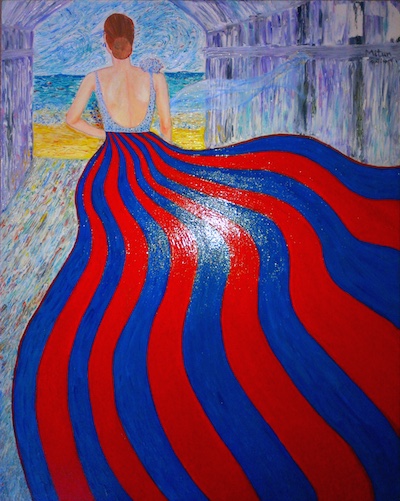
The composition and other details of the painting is a subject of another post. But to sum up, it’s a parallel world where so many things happen all at once: (1) there is the temporal journey from the present towards the future, (2) the cropped ocean of knowledge out there symbolizing our incomplete understanding, (3) a tunneled, cropped vision of our universe per se, and (4) yet-still our huge focus back on Planet Earth as a species and as individuals.
I planned a tight composition followed by a mixed painting style. This particular painting employs bits of Impressionism for the woman torso, Abstract Expressionism (palette knives) for the tunnel (expressive of the journey), Fauvism for the ocean, beach and sky, and Op Art for the gown.
The focus remains on the Earth even when we are looking out onto space – it’s our habit! In fact, the more we look elsewhere or scan the space, the more we focus back onto our planet – Op Art can bring this effect onto the canvas quite successfully. We cannot escape the pull of the earth, literally and figuratively.
This painting is dedicated to these 4 lines of verse from Ulysses. A tunnel and the journey forward:
I am a part of all that I have met; Yet all experience is an arch wherethro' Gleams that untravell'd world whose margin fades For ever and for ever when I move.
–Tennyson , Ulysses (Read the rest in Poetry’s website here.)
Example 2 (Combining Impressionism and Op Art)
Second example painting is from the view-perspective of a peahen searching for her mate. This oil painting titled “Peahen’s perspective of a peacock” invites the viewer to be that female bird as they look at the painting.
The composition provides opportunities to reflect, what if the eyespots of the tail feathers are the deciding factors for the peahens. How will that feel like to a human-eye looking through a peahen’s eye looking at an iridescent peacock looking for his mate?
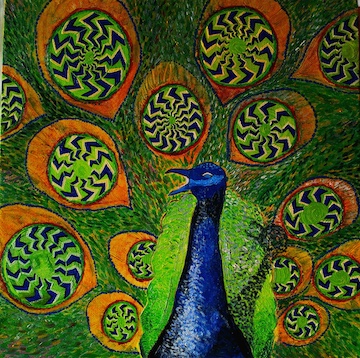
Scientifically, experts still haven’t been able to pinpoint the reason for the mating behaviors and a lot of experiment remains to be done in Behavioral Science before we know (or not).
The thought exercise in the composition could lead to more questions in the viewer’s mind. Or it might hopefully lead to general awareness in the field of study.
To bring forth the effect, focus and movement, a lot of Op Art techniques have been used of imperfect distorted geometries, together with Impressionism.
Example 3 (Combining Collage-print image transfer, Tiling, Abstraction and Op Art)
Third example is a painting triptych of a depiction of the space through the eyes of a telescope (with the awareness that it has its associated software simulations stitching together a final image from the numerous images it sees).

When scientists look through telescopes out into the space, there are certain regions of sky where one sees things clearly. At other spots, what we see is open to interpretations, open to new theories in physics and astronomy. The images compel us to focus at certain bright spots while the rest is [assumed to be] hazy dust clouds, or unknown knowledge awaiting theorizing. This equation of known-unknown along with the dynamics of dust clouds and moving, flashy galaxies has been captured in #1 and #2.
The #3 depicts a series of images stitched together somewhat repetitively. Photos taken by telescopes at different points of sky are not picture-perfect. The solution is to extract information from each to contribute to the whole, using softwares. In addition, one needs to identify and subtract the information-noise (read, photos of something else) that one sees; to separate the proverbial wheat from the chaff followed by analysis through closer inspection.
Example 4 (Combining Digital Art, Digital Impressionism and distortion, and Optical Illusion)
The fourth example is digital painting series titled “Runway”, models with faces distorted.
The Runway series invites these questions: Do we look at the models on fashion show ramps, or do we focus on the dresses? As humans where our subconscious tendency cannot ignore faces, how is a face or its legibility connected to the aesthetics of a dress or its commercial marketing aspects? How do the viewers’ eyes move?
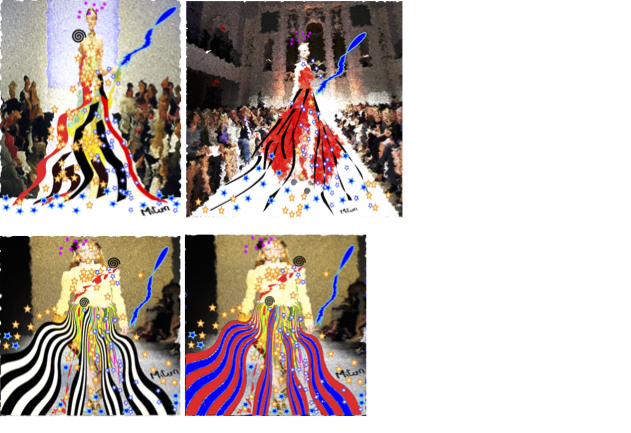
Example 5 (Combining Abstract Expressionism, Minimalism and Color fields)
The fifth example is of painting an age-old subject: clouds and cityscape. The painting is titled “Cloud, smoke, landmark and a simple city”. The techniques used are Abstract Expressionism drip painting for clouds, sky and smoke, and Minimalism for the cityscape skyline.
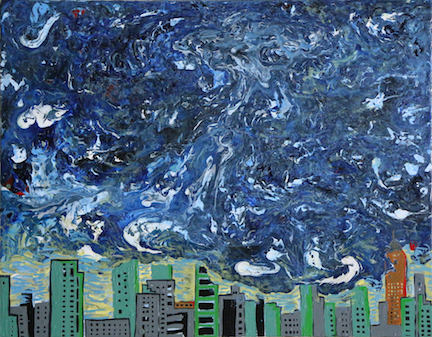
The complexity of sky juxtaposed with minimalist simplicity of land and landmarks, while acknowledging the tendency to seek out the landmarks in the skyline.
Final thoughts
After some explorations including the above, I think that a lot of subjects could be expressed in thought-provoking ways with a combinative approach, and a new visual language could thus be developed. These ponderings form the scaffold of my artistic practice and process.
